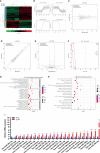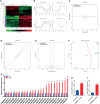Small Noncoding RNAome Changes During Human Bone Marrow Mesenchymal Stem Cells Senescence In Vitro
- PMID: 35634512
- PMCID: PMC9135970
- DOI: 10.3389/fendo.2022.808223
Small Noncoding RNAome Changes During Human Bone Marrow Mesenchymal Stem Cells Senescence In Vitro
Abstract
Bone marrow mesenchymal stem cells (BMSCs) have been used in stem cell-based therapy for various diseases due to their self-renewing ability and differentiation potential to various types of cells and immunoprivileged properties. However, the proliferation capability and functionality of BMSCs are known to decline with aging, which severely limits the extensive applications of BMSC-based therapies. To date, the exact mechanism involved in the cellular senescence of BMSCs remains unclear. RNA is thought to be the initial molecular form of life on earth. It also acts as a transmitter and important regulator of genetic information expression. There are many kinds of small noncoding RNAs with different functions in cells that regulate important life activity processes in multiple dimensions, including development process, gene expression, genomic stability, and cellular senescence. In this study, a replicative senescence model of hBMSCs was established and the expression changes of small noncoding RNAs during senescence were detected by small RNA high-throughput sequencing analysis and qPCR. Small RNA sequencing results showed that there were significant differences in the expression of 203 miRNAs, 46 piRNAs, 63 snoRNAs, 12 snRNAs, and 7 rasiRNAs. The results of qPCR, which was performed for the verification of the sequencing results, showed that there were significant differences in the expression of 24 miRNAs, 34 piRNAs, 34 snoRNAs, and 2 snRNAs. These findings might provide a novel insight into hBMSC senescence and contribute to the development of new targeting senescence strategies.
Keywords: bone marrow mesenchymal stem cells; miRNA; piRNA; senescence; snRNA; snoRNA.
Copyright © 2022 Xiao, Peng, Li, Zhou, Ma, Dai, Yuan, Chen and Wang.
Conflict of interest statement
The authors declare that the research was conducted in the absence of any commercial or financial relationships that could be construed as a potential conflict of interest.
Figures






Similar articles
-
Changes in the Small Noncoding RNAome During M1 and M2 Macrophage Polarization.Front Immunol. 2022 May 10;13:799733. doi: 10.3389/fimmu.2022.799733. eCollection 2022. Front Immunol. 2022. PMID: 35619693 Free PMC article.
-
Changes in Small Noncoding RNA Expression during Chondrocyte Senescence.Cartilage. 2022 Jul-Sep;13(3):19476035221118165. doi: 10.1177/19476035221118165. Cartilage. 2022. PMID: 35993268 Free PMC article.
-
Changes in the small noncoding RNA transcriptome in osteosarcoma cells.J Orthop Surg Res. 2023 Nov 24;18(1):898. doi: 10.1186/s13018-023-04362-8. J Orthop Surg Res. 2023. PMID: 38001513 Free PMC article.
-
Epigenetic therapy targeting bone marrow mesenchymal stem cells for age-related bone diseases.Stem Cell Res Ther. 2022 May 16;13(1):201. doi: 10.1186/s13287-022-02852-w. Stem Cell Res Ther. 2022. PMID: 35578312 Free PMC article. Review.
-
Long Noncoding RNAs: New Players in the Osteogenic Differentiation of Bone Marrow- and Adipose-Derived Mesenchymal Stem Cells.Stem Cell Rev Rep. 2018 Jun;14(3):297-308. doi: 10.1007/s12015-018-9801-5. Stem Cell Rev Rep. 2018. PMID: 29464508 Review.
Cited by
-
Cellular microenvironment: a key for tuning mesenchymal stem cell senescence.Front Cell Dev Biol. 2023 Dec 4;11:1323678. doi: 10.3389/fcell.2023.1323678. eCollection 2023. Front Cell Dev Biol. 2023. PMID: 38111850 Free PMC article. Review.
-
The emerging role of snoRNAs in human disease.Genes Dis. 2022 Dec 26;10(5):2064-2081. doi: 10.1016/j.gendis.2022.11.018. eCollection 2023 Sep. Genes Dis. 2022. PMID: 37492704 Free PMC article. Review.
-
Small Nucleolar RNAs: Biological Functions and Diseases.MedComm (2020). 2025 Jun 27;6(7):e70257. doi: 10.1002/mco2.70257. eCollection 2025 Jul. MedComm (2020). 2025. PMID: 40584410 Free PMC article. Review.
-
Reduced dynamicity and increased high-order protein assemblies in dense fibrillar component of the nucleolus under cellular senescence.Redox Biol. 2024 Sep;75:103279. doi: 10.1016/j.redox.2024.103279. Epub 2024 Jul 25. Redox Biol. 2024. PMID: 39111063 Free PMC article.
-
SnoRNAs: Exploring Their Implication in Human Diseases.Int J Mol Sci. 2024 Jun 29;25(13):7202. doi: 10.3390/ijms25137202. Int J Mol Sci. 2024. PMID: 39000310 Free PMC article. Review.
References
-
- Digirolamo CM, Stokes D, Colter D, Phinney DG, Class R, Prockop DJ. Propagation and Senescence of Human Marrow Stromal Cells in Culture: A Simple Colony-Forming Assay Identifies Samples With the Greatest Potential to Propagate and Differentiate. Br J Haematol (1999) 107:275–81. doi: 10.1046/j.1365-2141.1999.01715.x - DOI - PubMed
Publication types
MeSH terms
Substances
LinkOut - more resources
Full Text Sources
Molecular Biology Databases

